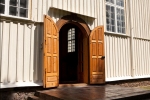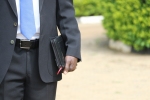July 30, 2014
Restoring To Wholeness And Strength
 “As you are outwardly anointed with this holy oil, so may our heavenly Father grant you the inward anointing of the Holy Spirit. Of his great mercy, may he forgive you your sins, release you from suffering, and restore you to wholeness and strength. May he deliver you from all evil, preserve you in all goodness, and bring you to everlasting life; through Jesus Christ our Lord.”
“As you are outwardly anointed with this holy oil, so may our heavenly Father grant you the inward anointing of the Holy Spirit. Of his great mercy, may he forgive you your sins, release you from suffering, and restore you to wholeness and strength. May he deliver you from all evil, preserve you in all goodness, and bring you to everlasting life; through Jesus Christ our Lord.”
From the Book of Common Prayer, p.456
Every Wednesday afternoon in our humble parish church in the quiet village of Valley Lee, Maryland, folks come forward, one by one, to receive the laying on of hands, anointing with oil, and prayers for God’s healing. Sometimes they ask healing for themselves. Sometimes it’s for someone they love. Even then, prayers are still offered for the one who is kneeling at the altar rail – that they, too, may be a vessel of God’s healing for their friend who is facing illness in body or mind or spirit. The celebration of Holy Communion follows those prayers, a sign of the ultimate healing we are granted through Christ.
This ritual happens so many times in so many parish churches and hospital rooms and bedrooms and living rooms. It happens so often that it may seem like just one more piece of church programming, like one more thing clergy or congregations do. But these moments of grace are no ordinary outward and visible sign; like every sacrament, they literally transform churches that seem quiet or hospital rooms which are eerily sterile into settings which are abuzz with God’s power.
Meanwhile, all across our communities, non-western healing arts are being practiced with regularity and intention. Yoga studios and music therapy rooms and counseling offices are also places where healing disciplines are practiced.
Growing the church sometimes means getting out of the church to see where God is acting elsewhere. Perhaps one opportunity can be found in the relationships and connections we make, in the name of Christ, with those practitioners of these healing arts. One of my friends, a massage therapist, rents space at a Lutheran church in his hometown. The church council and pastor have offered him a relatively low fee to rent that space in exchange for giving to the congregation one free massage every month, a gift which the pastor can then give to someone in the parish or community who needs it, a very real and tangible compliment to the pastoral work of the church.
What if we offered our space and, more than that, what if we offered a very real partnership?
That’s about to happen at St. George’s, Valley Lee, once again transforming this place which many may tend to think of as ‘quaint’ or ‘historic’ or, merely, ‘a place to get married / attend on Sundays’ into the locus of God’s re-creation. A relatively new member of our congregation long ago stepped away from institutional Christianity, having been steeped as a child in doctrinal certainty and what she experienced as insularity and exclusivity. Over the course of her years, she found Eastern traditions and got certified in non-western healing arts, but in her prayer life she kept coming back to Jesus. As she describes it, she had to go away from organized, institutional Christianity to come back, ultimately, to Christ. (Any parish priest can probably list, at first glance, twenty members of the congregation and, probably, twice as many non-active ‘members’ who would fall into this category.)
This parishioner, in addition to her secular employment, works with several other therapists to create a day of healing and wellness at various B&B’s and other places around our County, a kind of ‘pop-up shop’ of healing arts. They’ve got a well-cultivated mailing list and a dynamite marketing strategy. “Why don’t we do one of these events at our church,” she asked me? My response was simple: “Let’s talk.”
So we set up a lunch conversation with the others – one a massage therapist, one who practices reflexology, one who specializes in Reiki. I and the others, particularly those who are not active Christians, thought that that conversation was about allowing them to use our parish hall. But as we talked and shared, I realized that our Christian tradition, too, has within it something very similar to these practices and disciplines. In a few weeks, on a Saturday morning and afternoon at St. George’s, Valley Lee we will offer a “Day of Healing and Wellness.” These practitioners of the healing arts will set up their ‘pop-up shop’ in the various rooms of our parish hall and the caterer who works out of our church kitchen will offer healthy lunch options. Yoga sessions will be held in the hall, itself, and the church and grounds will be open all day for meditation and prayer. Also, in the middle of the day, no sessions will be offered and I will lead a service of Christian healing prayers and Holy Communion in the church, taking the order right from our Book of Common Prayer.
I will not say, nor do we intend to imply, that all of these practices are all alike, for that kind of lowest-common-denominator theology would not honor those other traditions – nor would it do justice to our own, very Christ-centered liturgies. (I’ll leave the mystery of God’s expansiveness up to God.) But there is no reason why these disciplines cannot happen in the very same place, and there is every good reason for a Christian parish church to use its space to encourage and lift up what it means to seek after healing, wholeness, peace – the very definition of that wonderfully expansive Hebrew word, shalom.
We have much to say about healing from our very own tradition. We also have much to learn from others. Thanks be to God!





